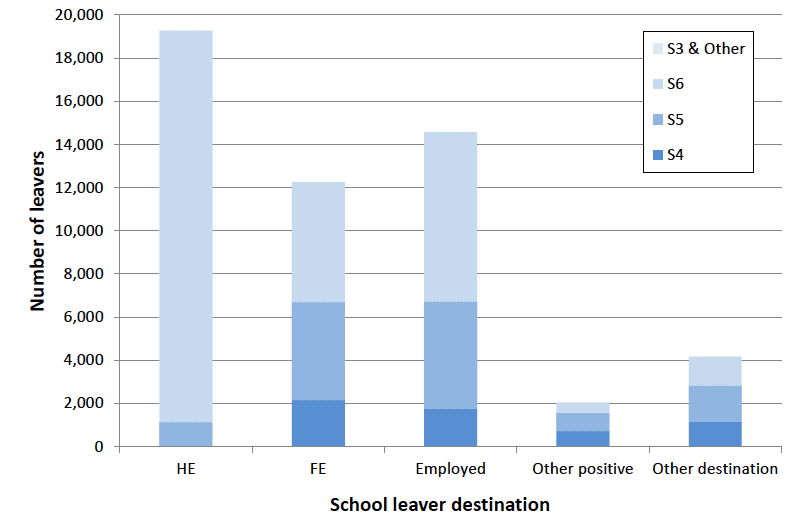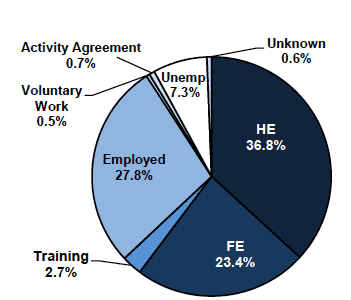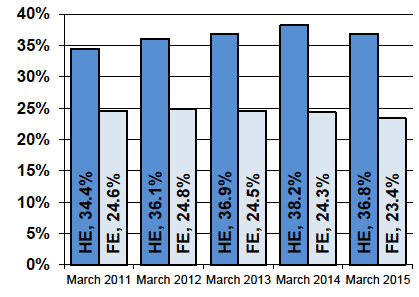Summary statistics for attainment, leaver destinations and healthy living, No.6: 2016 Edition
This publication presents post review attainment for 2014/15 school leavers, initial and follow-up school leaver destinations for 2014/15, and information on the healthy living survey taken in February 2016.
2. Leaver destinations
- 92.0% of 2014/15 leavers in a positive follow-up destination in March 2016 (91.7% for 2013/14)
- Almost two thirds of 2014/15 leavers left at the end of S6
- Scotland Performs National Indicator to "increase the proportion of young people in learning, training or work" shows performance maintaining
Skills Development Scotland leaver destinations data
2.1 Skills Development Scotland ( SDS) gather primary destination ( e.g. HE, employment etc.) information for young people they have identified as school leavers in the September after they leave school and again the following March. This information is used to inform 16+ Learning Choices , and other policy initiatives, and helps ensure that adequate support is provided for young people who may require help with entering and sustaining a positive destination.
2.2 SDS school leaver destinations are also used to monitor progress on the Scottish Government National Indicator: "increase the proportion of young people in learning, training or work". This year this National Indicator on the Scotland Performs website indicates 'performance maintaining'. The percentage in a positive initial destination in October 2015 was 92.9 per cent and the percentage in a positive follow-up destination in March 2016 was 92.0 per cent. This is a 0.5 percentage point increase on last year's follow-up figure of 91.5 per cent.
2.3 The National Indicator reflects the Opportunities for All commitment to an offer of an appropriate place in learning and training for those young people, aged 16-19, not already engaged in education, training or employment. It is currently still measured using the SDS school leaver destination information while systems are put in place to measure participation in learning, training or work for all 16 to 19 year olds. When this measure of participation for 16-19 year olds becomes available on an annual basis and sufficient reliable data is available to measure progress against this indicator, this will result in a fundamental change (no longer just school leavers) for this measure. For this reason and after consultation with Scotland Performs, it was recommended that any changes to measuring this National Indicator are deferred until the participation measure is fully developed. SDS released information on the participation of this age group in their 'Experimental Statistics - data being developed' publication titled 'Participation Measure for 16 - 19 year olds in Scotland'. This measure is based on a snapshot method and an annual measure is currently being developed to give a fuller picture of participation across the whole year rather than at one point in time.
2.4 SDS release initial leaver destinations data in December, which is available on their website ( http://www.skillsdevelopmentscotland.co.uk/statistics/school-leaver-destination-returns/). SDS also publish information on the follow-up destinations subsequent to this publication. Analysis of both the initial and follow-up destinations at a local authority level is available on their website ( https://www.skillsdevelopmentscotland.co.uk/publications-statistics/statistics/community-planning-partnership/)
Matched school leaver destinations
2.5 The school leaver destinations data is matched to the pupil census so that pupil characteristics and attainment data can be linked to the destinations. If a robust match can be made, more valuable conclusions can be drawn from the data. Only leavers with a match to the pupil census are included in the analysis within this publication. This means that some leavers are excluded from the analysis. (See background note 3.1 for more information on the matching process and the changes from previously published data). The timing of the school leaver cohort was changed for the 2014/15 leaver cohort, and therefore the 2013/14 cohort was revised to accommodate this change. (See background note 2.2 for information on changes to the timing of the school leaver cohort.)
2.6 For 2014/15 school leavers, almost two thirds (64 per cent) left at the end of S6, a quarter (25 per cent) left at the end of S5, and 11 per cent left at the end of S4. Around 0.1 per cent left in S3 or another stage. The following chart and table shows leavers by stage for 2014/15.
Table 1: Number and percentage of leavers by stage of leaving, 2014/15
| Stage of leaving | |||||
|---|---|---|---|---|---|
| Leavers | S6 | S5 | S4 | S3 | Other |
| Number | 33,444 | 13,173 | 5,814 | <50 | <20 |
| Percentage | 63.7% | 25.1% | 11.1% | <0.1% | <0.1% |
2.7 Between 2000/01 and 2008/09, the percentage of S4 pupils staying on at school until S6 remained largely unchanged at around 45 per cent. However, since 2009/10 the staying on rate has been increasing, reaching 63 per cent in 2015/16. Therefore the profile of leavers will have changed notably over this time period.
2.8 Looking at the follow-up destinations of 2014/15 school leavers by stage of leaving, it is clear that the majority of leavers who enter Higher Education remain at school until the end of S6. Chart 1 also shows:
- For S5 leavers, the most common follow-up destination in 2014/15 was employment (38 per cent of leavers) closely followed by Further Education (35 per cent).
- For S4 leavers, the most common destination was Further Education (37 per cent of leavers), although this accounts for less than a fifth of all the leavers in Further Education.
- Due to the small numbers of leavers from S3 or other stages it is difficult to represent this on the chart. Of the 41 leavers from S3, 78 per cent were in a positive destination in March 2016.
Chart 1. Follow-up destination of leavers by stage of leaving, 2014/15

1. Other positive includes activity agreements, training and voluntary work.
2. Other destination includes unemployed seeking, unemployed not seeking, and unknown.
2.9 Table 2 shows that percentage of all leavers in a positive follow-up destination in 2014/15 was 92.0 per cent, higher than in 2013/14 (91.7 per cent). This is lower than the initial percentage of 93.0 per cent. Although the percentage in a positive destination is the same as for the SDS figures used for the National Indicator, the number of leavers differs as the figures below only include leavers with a match to the pupil census.
2.10 The matching process was amended last year. This year data for 2009/10 and 2010/11 school leavers has been produced using the updated methodology so that more data is available on a comparable basis. (See background note 3.1 for more information.) Data for 2013/14 has also been revised following the changes to the timing of the school leaver cohort.
2.11 In March 2016, 60 per cent of the 2014/15 leavers were in Higher or Further Education, slightly lower than for 2013/14 leavers but similar to previous years. The proportion in employment has increased to 28 per cent from 26 per cent for 2013/14 leavers, while the percentage unemployed has decreased from 8 per cent for 2013/14 to 7 per cent for 2014/15 leavers.
Table 2. Percentage of school leavers by initial and follow-up destination category, 2010/11 to 2014/15
Column Percent (percentages may not total 100 due to rounding)
| 2010/11 | 2011/12 | 2012/13 | 2013/14 | 2014/15 | ||||||
|---|---|---|---|---|---|---|---|---|---|---|
| Destination Category | Initial | Follow Up 2 | Initial | Follow Up 2 | Initial | Follow Up 2 | Initial | Follow Up 2 | Initial | Follow Up 2 |
| Higher Education | 36.3 | 34.4 | 37.8 | 36.1 | 37.1 | 36.9 | 39.0 | 38.2 | 38.8 | 36.8 |
| Further Education | 27.1 | 24.6 | 26.6 | 24.8 | 27.7 | 24.5 | 26.3 | 24.3 | 27.6 | 23.4 |
| Training | 5.4 | 3.3 | 4.5 | 3.6 | 4.8 | 3.1 | 4.0 | 2.5 | 3.8 | 2.7 |
| Employment | 19.2 | 23.8 | 19.8 | 23.9 | 20.4 | 24.6 | 21.7 | 25.5 | 21.4 | 27.8 |
| Voluntary Work | 0.5 | 0.5 | 0.4 | 0.5 | 0.5 | 0.5 | 0.4 | 0.4 | 0.4 | 0.5 |
| Activity Agreement 1 | 0.5 | 0.6 | 0.9 | 0.7 | 1.3 | 0.9 | 1.0 | 0.7 | 0.9 | 0.7 |
| Unemployed Seeking | 9.5 | 10.2 | 8.1 | 8.1 | 6.9 | 7.6 | 6.2 | 6.5 | 5.4 | 5.7 |
| Unemployed Not Seeking | 1.2 | 1.6 | 1.3 | 1.8 | 1.1 | 1.6 | 1.1 | 1.5 | 1.1 | 1.6 |
| Unknown | 0.3 | 0.9 | 0.4 | 0.6 | 0.3 | 0.3 | 0.3 | 0.3 | 0.5 | 0.6 |
| Positive Destinations | 89.0 | 87.2 | 90.1 | 89.6 | 91.7 | 90.4 | 92.5 | 91.7 | 93.0 | 92.0 |
| Number of Leavers | 53,394 | 53,255 | 49,745 | 49,610 | 51,647 | 51,515 | 51,416 | 51,293 | 52,491 | 52,337 |
1. In April 2011 the Scottish Government rolled out the use of Activity Agreements.
2. Leavers who moved outwith Scotland, were deceased, or who had returned to school between the initial and the follow-up survey were excluded.
Chart 2. Follow-up destinations 2014/15

Chart 3. Percentage of leavers in HE & FE in follow-up

School leaver destinations by pupil characteristics
2.12 Table 3 shows the follow-up leaver destinations for pupils by various characteristics taken from the Pupil Census. Destinations have improved on the whole for most groups. The table shows the extent to which pupils from areas of high deprivation continue to be less likely to enter positive destinations, although they are improving at a faster rate than less deprived pupils. Pupils with additional support needs similarly are less likely to be in a positive destination but there has also been a high rate of improvement for this group. Leavers who identified their ethnicity as Asian - Chinese continue to have the highest proportion in positive destinations, although there was a drop from the 2013/14 figure (98.8 per cent down to 97.1 per cent). Girls also continue to be more likely to enter a positive destination than boys, but boys have made an improvement this year where girls have remained at the 2013/14 figure of 92.8 per cent. Splitting leavers by urban rural classification, large urban areas have seen the largest improvement since 2013/14 but continue to have the lowest percentage in positive destinations (91.5 per cent). More information on destinations by pupil characteristics is available in the supplementary tables. A list of the tables available is in the background notes.
2.13 The scope of this collection is limited to school leavers, but other sources are available to assess patterns across the wider society. For example, information on employment trends more broadly is available within the Labour Market section of the Scottish Government website, and the Scottish Funding Council publishes data on participation in Higher Education.
Table 3. Percentage of school leavers in a positive follow-up destination, by pupil characteristic, 2010/11 to 2014/15
| Percentage in a positive follow-up destination | |||||
|---|---|---|---|---|---|
| 2010/11 | 2011/12 | 2012/13 | 2013/14 | 2014/15 | |
| Gender | |||||
| Male | 86.0 | 88.5 | 89.3 | 90.6 | 91.3 |
| Female | 88.5 | 90.7 | 91.6 | 92.8 | 92.8 |
| Ethnicity 1 | |||||
| White - Scottish | N/A | 89.5 | 90.3 | 91.5 | 91.9 |
| White - non-Scottish | N/A | 89.9 | 92.1 | 92.8 | 92.1 |
| White - UK | 87.1 | N/A | N/A | N/A | N/A |
| White - Other | 89.4 | N/A | N/A | N/A | N/A |
| Mixed or multiple ethnic groups | 88.9 | 86.4 | 92.0 | 93.6 | 92.8 |
| Asian - Indian | 94.2 | 93.9 | 91.2 | 96.6 | 96.3 |
| Asian - Pakistani | 89.5 | 92.7 | 92.4 | 93.2 | 95.2 |
| Asian - Chinese | 94.3 | 98.3 | 98.8 | 98.8 | 97.1 |
| Asian - Other | 89.6 | 94.4 | 95.7 | 97.0 | 96.2 |
| African/ Black/ Caribbean 2 | 92.1 | 94.8 | 91.9 | 96.0 | 94.4 |
| All other categories 3 | 81.0 | 91.9 | 92.1 | 91.9 | 91.2 |
| Not Disclosed/Not known | 84.5 | 87.0 | 88.1 | 88.5 | 90.1 |
| Urban/Rural | |||||
| Large Urban Areas | 85.6 | 88.1 | 89.0 | 90.6 | 91.5 |
| Other Urban Areas | 87.6 | 89.9 | 90.4 | 91.4 | 91.6 |
| Accessible Small Towns | 88.8 | 90.2 | 92.1 | 93.1 | 93.4 |
| Remote Small Towns | 88.5 | 91.1 | 93.1 | 93.1 | 93.2 |
| Accessible Rural | 87.3 | 90.1 | 90.4 | 92.5 | 92.6 |
| Remote Rural | 91.5 | 93.5 | 94.2 | 95.5 | 95.6 |
| SIMD 4 | |||||
| 0-20% (most deprived) | 77.6 | 81.9 | 83.0 | 85.0 | 86.3 |
| 20-40% | 83.8 | 86.8 | 87.8 | 89.4 | 89.7 |
| 40-60% | 88.3 | 90.2 | 91.7 | 92.4 | 92.9 |
| 60-80% | 91.9 | 93.3 | 93.7 | 94.7 | 95.1 |
| 80-100% (least deprived) | 94.5 | 95.3 | 95.9 | 96.8 | 96.3 |
| Additional Support Needs 5 | |||||
| ASN | 75.7 | 82.0 | 82.5 | 84.3 | 85.7 |
| No ASN | 88.4 | 90.7 | 92.0 | 93.3 | 93.6 |
| All Leavers | 87.2 | 89.6 | 90.4 | 91.7 | 92.0 |
1. The categories used to collect ethnicity data changed in the 2011 pupil census to agree with the categories used in the main population census. This means they are not directly comparable with previous years and 'White - UK' and 'White - Other' could not be calculated for more recent years so are represented by N/A, and 'White-Scottish' and 'White-non-Scottish' could not be calculated for 2010/11. Some categories have been grouped together due to small numbers. Some categories contain between 100-200 leavers.
2. For 2011/12, 2012/13, 2013/14 and 2014/15 the 'African/ Black/ Caribbean' category includes 'African', 'African - Other', and the 'Caribbean or Black' categories.
3. For 2008/09 to 2010/11 'All other categories' includes 'Occupational,Gypsy and Other travellers' as well as the 'Other' category. For 2011/12, 2012/13 and 2013/14, 'All other categories' includes 'Other - other' and 'Other - Arab'.
4. Based on SIMD 2009 for 2010/11, and SIMD 2012 for 2011/12, 2012/13, 2013/14 and 2014/15. 2011/12 has been revised as all leavers are now matched by SIMD. More information on the Scottish Index of Multiple Deprivation can be found at: http://www.gov.scot/Topics/Statistics/SIMD.
5. Pupils who have a CSP, IEP or Other Support Plan.
Contact
There is a problem
Thanks for your feedback